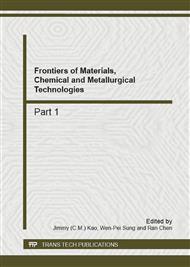p.847
p.851
p.856
p.861
p.868
p.873
p.879
p.883
p.888
Influence of the Mechanical Activation on the Reactivity of Germanium-Containing Zinc Neutral Leaching Residue
Abstract:
Zinc neutral leaching residue from conventional roast-leach-electrowin often contains a considerable content of germanium. In two-stage leaching process (weak acid leaching and hot acid leaching), dissolution yield of germanium as well as zinc is low due to the compact structure of the residue. In the paper, an attempt of increasing their dissolution yield was made by pretreatment of mechanical activation. The experimental results obtained show that the activated residue has much faster leaching kinetics, and that according to current technical standard operating in Yunnan Chihong Zinc & Germanium Co., Ltd, dissolution of germanium and zinc is increased by 18.12% and 22.93%, respectively. The increase may mainly be due to the structure deformation of the residue by further investigation.
Info:
Periodical:
Pages:
868-872
Citation:
Online since:
October 2012
Authors:
Keywords:
Price:
Сopyright:
© 2012 Trans Tech Publications Ltd. All Rights Reserved
Share:
Citation:


